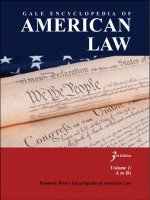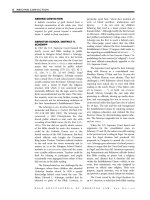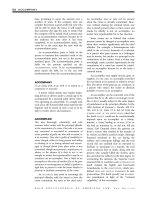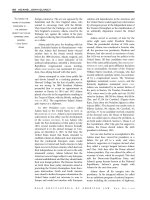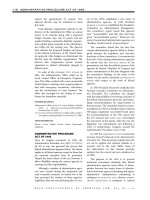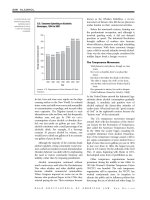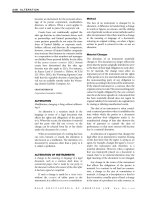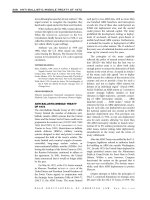Gale Encyclopedia Of American Law 3Rd Edition Volume 6 P52 pps
Bạn đang xem bản rút gọn của tài liệu. Xem và tải ngay bản đầy đủ của tài liệu tại đây (246.83 KB, 8 trang )
because of race, color, religion, sex, or national
origin. In addition, an employer cannot fire an
employee who is exercising certain rights, such
as filing a discrimination complaint with a
governmental agency or filing for worker’s
compensation benefits.
An employee can be discharged for mis-
appropriating funds, being unfaithful to his or
her employer’s interest, refusing to perform
services that were agreed upon in a contract, or
for being habitually late or absent. An employee
cannot be fired for insubordination for refusing
to subscribe to unlawful directives from his or
her employer, nor can the employee be required
to perform such illegal tasks as committing
perjury or handling stolen property. A suit for
damages may be brought against an employer
who wrongfully discharges an employee.
An employee has the obligation to be honest
and faithful in the performance of duties. When
trade secrets are disclosed to an employee, he or
she must not reveal them to others either prior
or subsequent to employment. In some cases,
an employment contract specifies that the
employer owns any new ideas or inventions
created by the employee during the period of
employment. When this is true, the employee
has no rights in the idea or invention nor any
right to ask for additional compensation.
Compensation
An employee can enter into an agreem ent to
work without compensation, but in the absence
of such an agreement, an employer must pay an
employee at the agreed rate. The employer
cannot delay payment of wages or substitute
something other than money unless the em-
ployee assents. The employee is entitled to his
or her wages as long as the work is completed. If
an employer wrongfully discharges an employ-
ee, the employee can collect all the money the
employer had agreed to pay him or her.
The amount and type of compensation is
ordinarily regulated by agreement; however, it is
affected by a number of statutes. Employers are
required to pay at least a certain prescribed
MINIMUM WAGE under most state laws, which
must be no less than the amount set by federal
law, unless it is a type of employment that is
excluded under the law or the employer is small
enough in size to be exempt from the minimum
wage laws. Other state and federal laws mandate
employers to allow for paid sick time and
additional wages for overtime or holiday work.
It constitutes a violation of federal law, the
Equal Pay Act (29 U.S.C.A. § 206 [1963]) to pay
men and women differen t wages for substan-
tially similar work. Special laws protect
INFANTS
(individuals under the age of majority) by
restricting the hours they can work at certain
ages and proscribing their employment in
certain kinds of jobs.
CROSS REFERENCES
Child Labo r Laws; Employment at Will; Employment Law;
Labor Law; Labor Union.
MATERIAL
Important; affecting the merits of a case; causing a
particular course of action; significant; substantial.
A description of the quality of evidence that
possesses such substantial
PROBATIVE value as to
establish the truth or falsity of a point in issue in a
lawsuit.
A material fact is an occurrence, event, or
information that is sufficiently significant to
influence an individual into acting in a certain
way, such as entering into a contract. In formal
court procedures, a material fact is anything
needed to prove one party’s case, or tending to
establish a point that is crucial to a person’s
position.
A material issue is a question that is in
dispute between two parties involved in liti-
gation, and that must be answered in order for
the conflict to be resolved.
A material witness is a person whose
testimony is a necessary element of a lawsuit.
An individual who is considered a material
witness can be compelled to appear in court and
provide testimony. In the event that the
person’s safety is endangered as a result of his
or her planned or actual testimony, he or she
may be given leg al protection or held in
PROTECTIVE CUSTODY.
MATHEWS V. ELDRIDGE TEST
A three-part test that determines whether an
individual has received DUE PROCESS under the
Constitution. The test balances (1) the importance
of the interest at stake; (2) the risk of an erroneous
deprivation of the interest because of the proce-
dures used, and the probable value of additional
procedural safeguards; and (3) the government’s
interest.
GALE ENCYCLOPEDIA OF AMERICAN LAW, 3RD E DITION
498 MATERIAL
Decisions by the Supreme Court in the 1960s
enhanced the due process rights of individuals
under both the Fifth and Fourteenth Amend-
ments. Aggrieved individuals used these pre-
cedents to litigate various issues involving the
termination of employment, government bene-
fits, professional licensure, and other interests
involving
ADMINISTRATIVE LAW matters. As a result,
the Supreme Court had to sort out how much
process was enough to constitute due process.
The Court resolved this issue in Mathews v.
Eldridge, 425 U.S. 319, 96 S.Ct. 893, 47 L.Ed.2d
18 (1976), when it announced a three-part
BALANCING test that lower courts must apply
when analyzing procedural due process cases.
In Mathews, the plaintiff accused the federal
government of terminating his
SOCIAL SECURITY
disability benefits without an evidentiary hear-
ing prior to termination. The claim was that
the administrative procedures in place by the
government violated his constitutional right to
due process. The Court acknowledged that the
receipt of benefits was an import ant private
interest, which satisfies the first part of the test
focusing on whether or not a private interest
is at stake. Later court decisions have shown
that this part of the test is subjective, calling on
courts to make judgment calls on the relative
merit of the interest at stake.
The second part of the test assesses the risk
of the possibility that a person will be mistakenly
deprived of the interest because of the need for
additional or different procedural safeguards. If
the risk of error is minimal, then the need for
additional procedures declines. If the risk is high
then additional procedures would be merited.
Government agencies also may reduce the risk of
erroneous deprivation by ensuring that regula-
tions are not
ARBITRARY or discriminatory, and by
defining reasonable classifications. In Mathews,
the Court ruled that administrative procedures
that were in place did not violate due proces s
rights; the plaintiff was offered several methods
to address the termination of benefits, but did
not choose to employ them.
The final part of the test deals with the
government’s interest. The Mathews court,
however, made it clear that in addition to
interest, administrative burdens also must be
factored into the analysis. If the need for
enhanced due process is merited by the need
to assure individuals that administrative actions
are just, then administrative costs should not
be considered. However, if the costs of the
additional procedures outweigh the benefits, then
the government should not be required to use
additional resources. The courts give “substantial
weight to the good-faith judgments” of officials
charged with government administration. In
Mathews, the Court ruled that an evidentiary
hearing was not required prior to the termination
of benefits and, therefore, the government’s
administrative procedures did not violate his
due process rights.
Some commentators have criticized the
three-part test as too subjective and impres-
sionistic, allowing judges to impose their
personal values on the relative worth of private
and government interests. For example, in its
ruling in Mathews the Court commented that
“the fundamental requirement of due process is
the opportunity to be heard ‘at a meaningful
time and in a meaningful manner.’” Such
undefined terminology opens the door for an
array of interpretations. Supporters, however,
contend that the bala ncing of the three parts
gives courts flexibility in assessing a particular
set of facts. Nevertheless, the test continues to
be applied by the Supreme Court and the lower
courts.
FURTHER READINGS
Carnathan, Sean T. 1993. “Due Process and the Independent
Medical Examiner System in the Maine Workers’
Compensation Act.” Maine Law Review 45.
Mashaw, Jerry L. 1976. “The Supreme Court’s Due Process
Calculus for Administrative Adjudication in Mathews v.
Eldridge: Three Factors in Search of a Theory of Value.”
Univ. of Chicago Law Review 44.
Schwartz, Bernard. 1995. A History of the Supreme Court.2d
ed. New York: Oxford Univ. Press.
MATTER OF FACT
That whi ch is to be determined by the senses or by
the testimony of witnesses who describe what they
have perceived through the senses of sight, smell,
touch, taste, and hearing.
Trials are highly complex forums for the
consideration of fact, opinion, and law. Each
area is distinct in its type and in who has
responsibility for evaluating it. Courts use the
term matter of fact to distinguish a particular
kind of information. A fact is a thing done—an
actual occurrence or event—and it is presented
during a trial in the form of testimony and
evidence. The
RULES OF EVIDENCE generally allow
witnesses to testify as to what they personally
know about the facts in dispute, but do not
GALE ENCYCLOPEDIA OF AMERICAN LAW, 3RD E DITION
MATTER OF FACT 499
allow witnesses to testify as to their opinions
(i.e., thoughts, beliefs, or infere nces) in regard
to those facts. An exception is made for expert
witnesses, whose technical or scientific specialty
is considered sufficient to allow them to state
their opinion on relevant and material matters.
Facts are often difficult to ascertain because
the record is unclear or because competing
interpretations of the facts are presented.
QUES-
TIONS OF FACT
are for the jury, which must weigh
their validity in reaching a verdict. The jury’s
role is kept distinct from that of the court, which
has the authority to rule on all matters of law.
CROSS REFE RENCE
Matter of Law.
MATTER OF LAW
That which is determined or ascertained through
the use of statutes, rules, court decisions, and
interpretations of legal principles.
In legal actions the term matter of law is used
to define a particular area that is the responsi-
bility of the court. Matter of law is distinguished
from matter of fact. All questions concerning the
determination of fact are for the jury, though a
judge may determine the facts if a jury trial is
waived or is not permitted under the law.
The designation of matters of law to the judge
and matters of fact to the jury did not develop,
however, until the late eighteenth century. Until
that time a jury could exercise its judgment over
matters of fact and law. Jury instructions, which
in modern law are technical and specific about
which law to apply, were informal and general. A
jury was free to accept the instructions, modify
them, or ignore them completely.
By the middle of the nineteenth century,
courts had acquired authority over matters of
law and confined juries to matters of fact.
Commercial lawyers were particularly influen-
tial in bringing about this change, as greater
judicial control over matters of law helped
produce a stable legal system in which business
could prosper.
In the early twenty-first century, courts rule
on all matters of law, including pretrial
motions, trial objections to the introduction
of particular evidence or testimony, proposed
jury instructions, and posttrial motions. Their
decisions are based on statutes,
RULES OF EVIDENCE
and procedure, and the body of relevant
case law.
When the facts in a civil action are not in
dispute, one or both of the parties may request a
court to make a
SUMMARY JUDGMENT.Summary
judgment is purely a matter of law; the court
accepts the relevant facts as presented by the party
opposing summary judgment and renders a
decision based on the applicable legal principles.
A matter of law can be the basis for an
appeal, but generally a matter of fact cannot.
Though an appeals court can reverse a decision
because of a mistaken matter of law, it will not
reverse if the mistake did not affect the verdict.
This “harmless error” rule developed, in part,
from the recognition that during a trial the
court often must make hundreds of decisions
based on matters of law.
MATTER OF RECORD
Anything that has been entered in the formal
written record of a court, which can be proved by
the production of that record.
A court produces a lengthy written record of
a trial. A matter of record is anything entered in
the official court record, including pleadings,
testimony, evidence, motions, objections, rul-
ings, and the verdict. Any matter of record can
be proved by producing the relevant document
from the trial court record.
Proving matters of record is especially
important in petitions for appeal. When appellate
courts determine whether to hear an appeal, the
existence of a matter of record can be decisive: the
record can conclusively refute allegations con-
tained in the petition. Thus, for example, an
appeal based on something said in testimony
must be supported by the record; if it is not, the
court may deny the petition without any further
consideration. An appellate court in most
instances will not consider evidence, issues, or
objections that were not made a part of the record
at trial. Getting an issue into the record at trial is
said to preserve the issue for appeal.
In general, matters of record are available to
the public unles s state law or court order
prevents them from being released. For exam-
ple, courts typically refuse to release the names
of minors who are victims of sexual assault.
Rhode Island’s family court rules of practice
provide another example; matters of record
“involving scandal or imm oral practices” are
kept private except from the parties in interest
or their representatives (R.I. R. Fam. Ct. Prac.
Rule 3.3).
GALE ENCYCLOPEDIA OF AMERICAN LAW, 3RD E DITION
500 MATTER OF LAW
v
MATTHEWS, STANLEY
Stanley Matthews served as associate justice
of the U.S. Supreme Court from 1881 to 1889.
A longtime friend and adviser to President
RUTHERFORD B. HAYES, Matthews proved an
effective and hardworking member of the Court
during his brief tenure. His 1859 prosecution of
a reporter for aiding the escape of two fugitive
slaves proved politically embarrassing in later
years. However, his opinion in
YICK WO V.
HOPKINS, 118 U.S. 356, 6 S. Ct. 1064, 30 L. Ed.
220 (1886), established an enduring principle of
EQUAL PROTECTION analysis under the FOURTEENTH
AMENDMENT
.
Matthews was born July 21, 1824, in
Cincinnati. He preferred his middle name and
dropped his first name, Thom as, in his adult
life. He graduated from Kenyon College in 1840
and then studied law in Cincinnati. He was
admitted to the Tennessee bar in 1842 and
began a law practice in Columbia, Tennesse e.
Matthews also devoted himself to journalism,
editing the Tennessee Dem ocrat newspaper. He
returned to Ohio in 1845 to become editor of
the Cincinnati Morning Herald.
Soon Matthews was drawn into politics and
public service. He became clerk of the Ohio
House of Representatives in 1848, then left in
1851 to sit as judge on the court of
COMMON
PLEAS
in Hamilton County, Ohio. He was elected
to the Ohio Senate in 1855, where he served
until 1857.
Matthews was appointed U.S. attorney for
the Southern District of Ohio in 1858 . In 1859
he prosecuted W. B. Connelly, a local reporter,
under the federal
FUGITIVE SLAVE ACT, for assisting
two runaway slaves. Though Matthews was an
abolitionist, he duly enforced the law. Critics
charged him with forsaking his conscience in
the hope of furthering his legal and political
careers. Matthews never escaped the taint of
these accusations.
When the Civil War broke out, Matthews
enlisted in the Twenty-third Ohio Infantry as a
lieutenant colonel, under the command of
Hayes, a college classmate and friend. He left
the army in 1863, following his election as a
judge of the Cincinnati Superior Court. He held
that post until 1865, when he resumed his
private law practice.
Matthews aided his friend Hayes in the 1876
presidential election, against
SAMUEL J. TILDEN,the
Stanley Matthews 1824–1889
▼▼
▼▼
18251825
19001900
18751875
1850 1850
❖
◆◆
1858 Appointed U.S. Attorney for the Southern District of Ohio
1824 Born,
Cincinnati,
Ohio
1851–53 Served as judge on court of
common pleas in Hamilton County, Ohio
1842 Admitted to
Tennessee bar
1845 Became
editor of
Cincinnati
Morning
Herald
1855–57
Served
in Ohio
Senate
1863–65 Served as judge
of the Ohio Superior Court,
Cincinnati
1859 Prosecuted W.B. Connelly under the Fugitive
Slave Act for assisting two runaway slaves
1861–65
U.S. Civil War
1877–81
Served in
U.S.
Senate
1881–89 Served as associate
justice of the Supreme Court
◆
◆
1861–63 Served in the Ohio Infantry
1884 Authored Hurtado v. California opinion
1886 Authored Yick Wo v. Hopkins opinion
1889 Died,
Washington, D.C.
❖
◆
◆
Stanley Matthews.
PHOTOGRAPH BY
MATHEW BRADY.
COLLECTION OF
THE SUPREME COURT
OF THE UNITED STATES
GALE ENCYCLOPEDIA OF AMERICAN LAW, 3
RD E DITION
MATTHEWS, STANLEY 501
Democratic governor of New York. An electoral
commission was formed by Congress in early
1877 to resolve disputes over the electoral votes
in several states. Matthews represented Hayes
and the
REPUBLICAN PART Y , successfully arguing
that Hayes should be awarded all the disputed
votes and thus become president.
Matthews was elected to the U.S. Senate in
1877. In 1880 Hayes nominated him to the
Supreme Court. The Senate rejected his nomi-
nation, in part because of his 1859 prosecution
of Connelly under the fugitive slave law and
also because he had represented railroads and
corporations in his law practice. Some senators
argued that this would affect Matthews’s
judgment in cases on these issues.
In 1881 President
JAMES GARFIELD nominated
Matthews to the Court. This time he was
confirmed by one vote.
During his nearly eight years on the Court,
Matthews authored 232 opinions and five
dissents. In
HURTADO V. CALIFORNIA, 110 U.S.
516, 4 S. Ct. 111, 28 L. Ed. 232 (1884), Matthews
rejected the idea that the Fifth and Fourteenth
Amendments’
DUE PROCESS provisions required
states to prosecute citizens solely through the
GRAND JURY indictment process. Matthews wrote
that as long as the defendant had notice and an
opportunity to prepare a defense to the charges,
due process was provided.
Matthews is most famous for his opinion in
Yick Wo. In this opinion Matthews invalidated a
San Francisco ordinance requiring owners of
laundries housed in wooden buildings to obtain
permission from the city government to con-
tinue the operation of their business. Although
the language of the ordinance was neutral,
it was administered in such a way that Chinese
laundry owners were denied licenses and
nearly all non-Chinese applicants were granted
licenses. Matthews looked past the neutral
language to strike down the ordinance as a
violation of the Fourteenth Amendment’s Equal
Protection Clause, concluding that unequal
application of the ordinance furthered “unjust
and illegal discrimination.” Matthews’s opinion
became the foundation for modern civil rights
cases involving
DISPARATE IMPACT, in which
discrimination is established by statistical in-
equality rather than through proof of intentional
discrimination.
Matthews died March 22, 1889, in Washing-
ton, D.C.
MAXIM
A broad statement of principle, the truth and
reasonableness of which are self-evident. A rule of
EQUITY, the system of justice that complements
the
COMMON LAW.
Maxims were originally quoted in Latin,
and many of the Latin phrases continue to be
familiar to lawyers in the early 2000s. The
maxims were not written down in an organized
code or enacted by legislatures, but they have
been handed down through generations of
judges. As a result, the wording of a maxim
may vary from case to case. For example, it is a
general rule that equit y does not aid a party at
fault. This maxim has been variously expressed:
n
No one is entitled to the aid of a court of
equity when that aid has become necessary
through his or her own fault.
n
Equity does not relieve a person of the
consequences of his or her own carelessness.
n
A court of equity will not assist a person in
extricating himself or herself from the
circumstances that he or she has created.
n
Equity will not grant relief from a self-
created hardship.
The principles of equity and justice are
universal in the common-law courts of the
world. They are flexible principles aimed at
achieving justice for both sides in each case. No
maxim is ever absolute, but all of the principles
must be weighed and fitted to the facts of an
individual controversy. A rule does not apply
when it would produce an unfair result. A
party cannot insist that a strict technicality be
enforced in his or her favor when it would
create an injustice because equity will instead
balance the interests of the different parties
and the convenience of the public.
The Foundations of Equity
Two maxims form the primary foundations
of equity: Equity will not suffer an injustice and
equity acts in personam. The first of these
explains the whole purpose of equity, and the
second highlights the personal nature of equity.
Equity looks at the circumstances of the
individuals in each case and fashions a remedy
that is directed at the person of the defendant
who must act accordingly to provide the
plaintiff with the specified relief. Unless a
statute expands the powers of an equity court,
it can make decrees that concern property only
indirectly, phrasing them as decrees against
THE EXERCISE OF
FUNDAMENTAL
RIGHTS
, INCLUDING
THE RIGHT TO PURSUE
A PROFESSION OR
TRADE
[MUST] NOT
BE MADE SUBJECT TO
THE EXERCISE OF
ARBITRARY
GOVERNMENTAL
POWER
.
—STANLEY
MATTHEWS
GALE ENCYCLOPEDIA OF AMERICAN LAW, 3RD E DITION
502 MAXIM
persons. It is said that these are the oldest two
maxims of equity. All others are consistent with
them.
“He Who Seeks Equity Must
do Equity.”
This maxim is not a moral persuasion but an
enforceable
RULE OF LAW. It does not require
every plaintiff to have an unblemished back-
ground in order to prevail, but the court will
refuse to assist anyone whose
CAUSE OF ACTION is
founded on his or her own misconduct toward
the other party. If, for example, a wealthy
woman tricks her intended spouse into signing
a prenuptial agreement giving him a token
$500 should they
DIVORCE and after marriage
she engages in a consistent pattern of conduct
leading to a divorce, a court could refuse to
enforce the agreement. This maxim reflects one
aspect of the principle known as the clean hands
doctrine.
“He Who Comes into Equity Must
Come with Clean Hands.”
This maxim bars relief for anyone guilty of
improper conduct in the matter at hand. It
operates to prevent any affirmative recovery for
the person with “unclean hands,” no matter
how unfairly the person’s adversary has treated
him or her. The maxim is the basis of the clean
hands doctrine. Its purpose is to protect the
integrity of the court. It does not disapprove
only of illegal acts but will deny relief for bad
conduct that, as a matter of public policy, ought
to be discouraged. A court will ask whether the
bad conduct was intentional. This rule is not
meant to punish carelessness or a mistake. It is
possible that the wrongful conduct is not an act
but a failure to act. For example, someone who
hires an agent to represent him or her and then
sits silently while the agent misleads ano ther
party in negotiations is as much responsible for
the false statements as if he himself or she
herself had made them.
The bad conduct that is condemned by the
clean hands doctrine must be a part of the
transaction that is the subject of the lawsuit. It
is not necessary that it actually have hurt the
other party. For example, equity will not relieve
a plaintiff who was also trying to evade taxes
or defraud creditors with a business deal, even
if that person was che ated by the other party in
the transaction.
Equity will always decline relief in cases in
which both parties have schemed to circumvent
the law. In one ve ry old case, a robber filed a bill
in equity to force his partner to account for a
sum of money. When the real natur e of the
claim was discovered, the bill was dismissed
with costs, and the lawyers were held in
CONTEMPT of court for bringing such an action.
This famous case has come to be called The
Highwayman (Everet v. Williams, Ex. 1725, 9
L.Q. Rev. 197), and judges have been saying
ever since that they will not sit to take an
account between two robbers.
“Equity Aids the Vigilant, not Those
Who Slumber on Their Rights.”
This principle recognizes that an adversary can
lose evidenc e, witnesses, and a fair chance to
defend himself or herself after the passage of
time from the date that the wrong was
committed. If the defendant can show dis-
advantages because for a long time he or she
relied on the fact that no lawsuit would be
started, then the case should be dismissed in the
interests of justice. The law encourages a speedy
resolution for every dispute. It does not favor
the cause of someone who suddenly wakes up to
enforce his or her rights long after discovering
that they exist. A long unreasonable delay such
as this is called
LACHES, and it is a defense to
various forms of equitable relief.
“Equity Follows the Law.”
Equity does not replace or violate the law, but it
backs it up and supplements it. Equity follows
appropriate
RULES OF LAW, such as the RULES OF
EVIDENCE
and pretrial discovery.
“Equity Acts Specifically.”
This maxim means that a party who sues in
equity can recover the precise thing that he or
she seeks rather than monetary damages as a
substitute for it. This maxim is the remedy of
SPECIFIC PERFORMANCE.
“Equity Delights to do Justice and Not
by Halves.”
It is the purpose of equity to find a complete
answer to the issues that are raised in a lawsuit.
It will bring in all the necessary parties, balance
their rights, and give a decree that should
protect all of them against further litigation
on the subject. Whenever necessary, the court
will retain jurisdiction in order to supervise
GALE ENCYCLOPEDIA OF AMERICAN LAW, 3RD E DITION
MAXIM 503
enforcement of relief. For example, a lawsuit
remains alive as long as an INJUNCTION is in force.
Either party may come back into court and
apply for reconsideration of the order if circum-
stances change. Courts also retain jurisdiction
when
CHILD SUPPORT payments are ordered. The
amount can be changed if the child’sneeds
require an increase or if the supporting parent
becomes ill, unemployed, or retired.
“Equity will not Suffer a Wrong to be
without a Remedy.”
It is the traditional purpose of equity to find
solutions in lawsuits. Where money will not
pay for the injury, equity has the authority to
find another remedy.
This maxim is a restatement of the broad
legal principle: Ubi jus, ibi remedium, “Where
there is a right, there is a remedy.” The maxim is
applied in equity in an orderly way. It does not
mean that anything goes. It calls forth recognized
remedies for well-established wrongs, wrongs
that are invasions of property rights or personal
or
CIVIL RIGHTS and that the law considers
actionable. A court will not listen to complaints
about every petty annoyance or immoral act.
“Equity Regards Substance Rather
than Form.”
Equity will not permit justice to be withheld just
because of a technicality . Formalities that
frustrate justice will be disregarded and a better
approach found for each case. Equity enforces
the spirit rather than the letter of the law alone.
“Equity is Equality.”
This maxim means that equity will not play
favorites. For example, a receiver who has been
appointed to collect the assets of a business in
financial trouble must use the income to pay
every creditor an equal share of what is owed
to him or her. If a
PENSION fund loses a large
amount of money through poor investment, then
everyone who is entitled to benefits must suffer a
fair share of the loss. Three adult children of a
woman who is killed in an auto accident should
share equally in any money that is recovered in
a
WRONGFUL DEATH action if the children are the
woman’s only surviving close relatives.
A judge will depart from this principle only
under compelling circumstances, but the rule
applies only to parties who are on an equal
footing. If, for example, the woman in an auto
accident died leaving three young children, then
the money that is recovered might be distributed
in proportion to each child’s age. A younger
child will have lost his or her mother for more
years than an older brother or sister. Also, a
receiver would have to prefer a secured creditor
over those creditors who had no enforcea ble
interest in a particular asset of the company.
Unless there is proo f that one person in a group
is in a special position, the law will assume
that each should share equally in proportion to
his or her contribution or loss.
“Between Equal Equities the Law will
Prevail.”
When two parties want the same thing and the
court cannot in good conscience say that one
has a better right to the item than the other, the
court will leave it where it is. For example, a
company that had been collecting sales tax and
turning it over to the state government found
that it had overtaxed and overpaid by 2 percent.
It applied for a refund, but the state refused.
The court upheld the state on the ground
that the money really belonged to the customers
of the company. Because the company had no
better right to the money than the state, the
court left the money with the state.
“Between Equal Equities the First in
Order of Time Shall Prevail.”
When two parties each have a right to possess
something, then the one who acquired an
interest first should prevail in equity. For
example, a man advertises a small boat for sale
in the classified section of the newspaper. The
first person to see the ad offers him $20 less
than the asking price, but the man accepts it.
That person says he or she will pick up the boat
and pay for it on Saturday. Meanwhile another
person comes by, offers the man more money,
and the man takes it. Who owns the boat?
Contract law and equity agree that the first
buyer gets the boat, and the second buyer gets
his or her money back.
“Equity Abhors a Forfeiture.”
A FORFEITURE is a total loss of a right or a thing
because of the failure to do something as
required. A total loss is usually a rather stiff
penalty. Unless a penalty is reasonable in
relation to the seriousness of the fault, it is too
harsh. In fairness and good conscience, a court
of equity will refuse to permit an unreasonable
forfeiture. This maxim has particularly strong
GALE ENCYCLOPEDIA OF AMERICAN LAW, 3RD E DITION
504 MAXIM
application to the ownership of land, an interest
for which the law shows great respect. Title to
land should never be lost for a trivial reason—
for example, a delay of only a few days in
closing a deal to purchase a house.
Generally equity will not interfere with a
forfeiture that is required by statute, such as the
loss of an airplane illegally used to smuggle drugs
into the country. Unless the statute violates the
DUE PROCESS requirements of the Constitution, the
penalty should be enforced. “Equity abhors a
forfeiture” does not overcome the maxim that
“equity follows the law.”
Neither will equity disregard a contract pro-
vision that was fairly bargained. Generally it is
assumed that a party who does most of what is
required in a business contract and does it in a
reasonable way, should not be penalized for the
violation of a minor technicality. A contractor
who completes work on a bridge one day late, for
example, should not be treated as though he or
she had breached the entire contract. If the
parties, however, include in their agreement an
express provision, such as t ime is of the ess ence,
this means that both parties understand that
performance on time is essential. The party who
fails to perform on time would forfeit all rights
under the contract.
FURTHER READINGS
Broom, Heerbert, ed. 2008. A Selection of Legal Maxims:
Classified and Illustrated (1854). Whitefish, MT:
Kessinger.
Hoffer, Peter Charles. 1990. The Law’s Conscience: Equitable
Constitutionalism in America. Chapel Hill: Univ. of
North Carolina Press.
Kraut, Jayson, et al, eds. 1983. American Jurisprudence.
Rochester, NY: Lawyers Cooperative.
CROSS REFERENCES
Equity; Forfeiture; Laches.
MAYHEM
Mayhem at COMMON LAW required a type of injury
that permanently rendered the victim less able
to fight offensively or defensively; it might be
accomplished either by the removal of (dismem-
berment), or by the disablement of, some bodily
member useful in fighting. Today, by statute,
permanent disfigurement has been added; and
as to dismemberment and disablement, there is
no longer a requirement that the member have
military significance. In many states the crime of
mayhem is treated as aggravated assault.
GALE ENCYCLOPEDIA OF AMERICAN LAW, 3RD E DITION
MAYHEM 505
